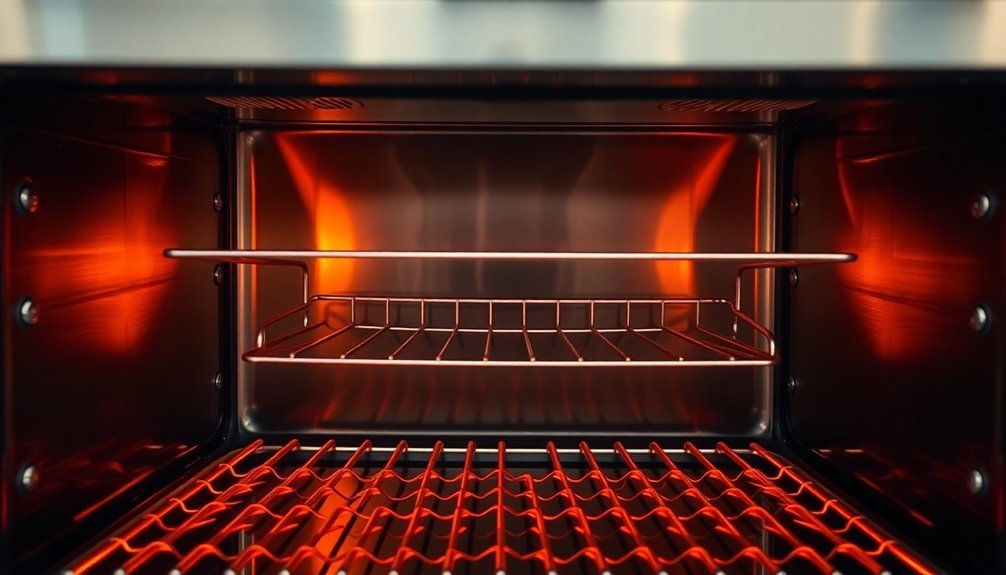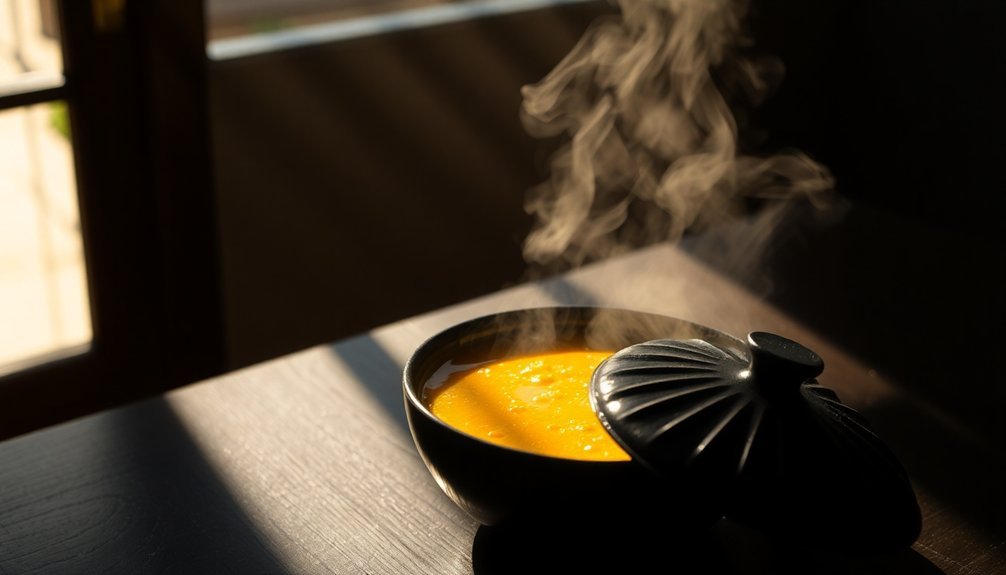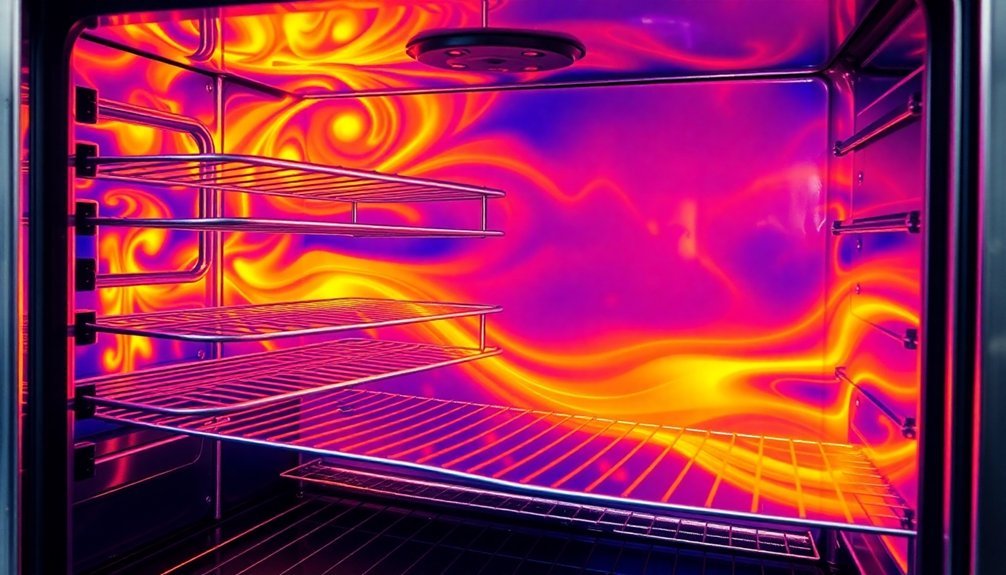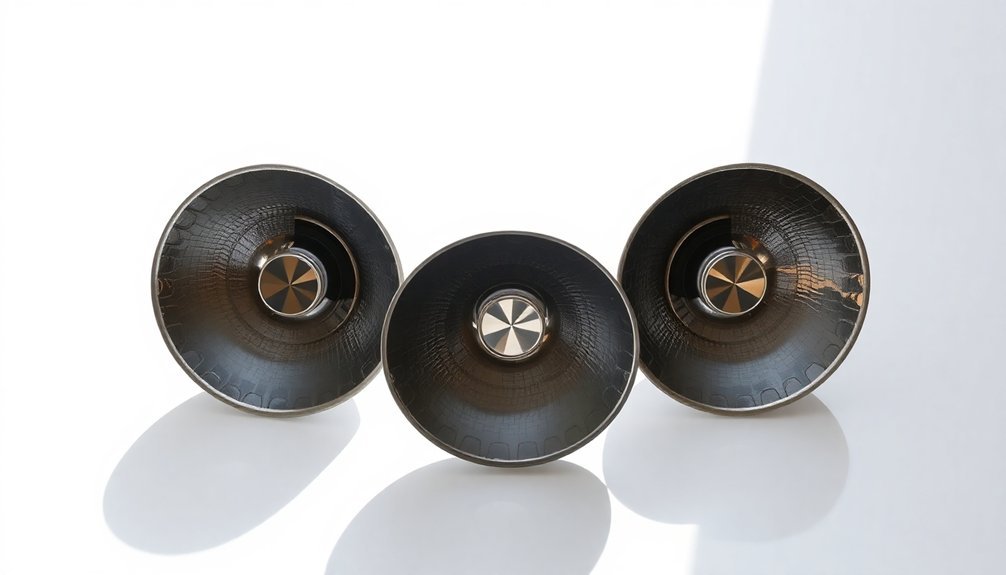To maximize your solar oven's cooking power, position your reflector panels at a 60-degree angle for standard-sized reflectors, or 110-112.5 degrees if you're using taller panels. You'll get the best results between 10 am and 4 pm, with peak efficiency from 11 am to 3 pm when the sun is directly overhead. Remember to adjust your angles seasonally – use flatter angles in summer and steeper tilts in winter. Keep in mind that you've got about 15 degrees of tolerance for effective unattended cooking. With proper positioning and a few key techniques, you can greatly boost your solar oven's performance.
Understanding Solar Oven Angles

When building a solar oven, understanding the correct angles for your reflectors can dramatically improve its cooking efficiency. You'll want to position your reflectors at approximately 60 degrees, ensuring they match the width of your target cooking area. This angle helps maximize sunlight capture while directing rays precisely where you need them. The capture area depends on both reflector length and angle, with longer reflectors increasing power when properly positioned.
To achieve ideal performance, you'll need to take into account angular tolerance, which should be around 15 degrees for unattended cooking. Using a protractor, measure and adjust your reflectors so the reflected rays match incoming angles.
Remember that solar movement affects your oven's effectiveness throughout the day, so you might need to tilt the entire unit using props. Position your reflectors to direct sunlight to opposite sides of your target, and don't forget that proper alignment is vital for maintaining consistent cooking temperatures.
Best Time for Solar Cooking
Since solar cooking relies heavily on the sun's intensity, you'll achieve the best results between 10 am and 4 pm, with peak performance occurring from 11 am to 3 pm. During these hours, the sun's overhead position maximizes UV rays and cooking temperatures, making your solar oven most efficient. Using dark pots and pans will help your solar oven cook more effectively by absorbing heat better.
- Feel the satisfaction of harnessing nature's power when your meals cook perfectly during peak sunlight hours
- Experience stress-free cooking in summer months when your oven can be left unattended longer
- Embrace the challenge of seasonal adjustments as you track the sun's movement
- Discover the joy of eco-friendly cooking even on partly sunny days
Remember to position your oven where it receives direct sunlight and use dark cookware to enhance heat absorption.
While cooking times are typically double those of conventional ovens, the wait is worth the sustainable results you'll achieve.
Seasonal Angle Adjustments

You'll need to adjust your solar oven's position throughout the year, with summer requiring a flatter angle to capture the high sun and winter demanding a steeper tilt to maximize the lower sun path.
During winter months, you're likely to experience more heat loss due to the sun's weaker intensity and shorter daylight hours, making proper angle positioning even more critical. Well-insulated solar ovens can still maintain high cooking temperatures despite cold weather conditions.
Spring and fall often provide ideal solar cooking conditions since moderate sun angles allow for easier positioning and more consistent energy collection throughout the day.
Summer Sun Oven Positioning
Proper sun oven positioning becomes especially critical during summer months when the sun reaches its highest point in the sky.
You'll need to position your oven in a completely unobstructed area and face it directly toward the sun. Using the E-Z Sun-track indicators, align your oven until the round dot of light centers perfectly over the bottom hole.
Set your reflective panels at a 60-degree angle from the oven's opening to capture maximum sunlight.
You'll find you need fewer adjustments with this ideal angle during summer cooking sessions.
- Feel the satisfaction of perfect alignment when shadows fall evenly on both sides
- Experience the thrill of reaching peak temperatures quickly
- Enjoy the freedom of less frequent position adjustments
- Savor the confidence of knowing you're harnessing maximum solar power
Winter Baking Heat Loss
During winter months, maintaining consistent oven temperatures requires strategic adjustments to combat heat loss.
You'll need to use an oven thermometer to verify your temperature readings and adjust your dial settings accordingly. When making changes, remember that every 25°F shift requires an inverse adjustment of 2-3 minutes to your baking time.
To maximize your oven's efficiency in cold weather, guarantee proper insulation and door sealing.
You'll want to start with higher initial heat to counteract the colder ambient temperatures, then adjust as needed. Position your racks strategically to manage heat distribution, and monitor your baking more closely as winter conditions can affect oven performance.
Don't adjust temperatures mid-bake, as this can disrupt the oven's natural cycling and lead to inconsistent results.
Spring-Fall Energy Sweet Spot
While conventional ovens maintain consistent temperatures year-round, solar ovens require specific angle adjustments to maximize their efficiency during spring and fall months.
You'll find that setting your oven's tilt to match your latitude creates an ideal balance for these shifting seasons. For example, if you're at 30 degrees latitude, tilt your oven at 30 degrees facing south.
- Feel confident knowing you won't need frequent adjustments during these seasons
- Experience the satisfaction of consistent cooking performance as days grow longer or shorter
- Enjoy peace of mind with a set-and-forget angle that works for months at a time
- Delight in achieving maximum energy capture without complex calculations
This balanced approach guarantees your solar oven captures sufficient sunlight while maintaining stable cooking temperatures throughout spring and fall.
Maximum Heat Collection Points
You'll find ideal heat collection points by understanding how heat distributes at different angles in your oven, with the bottom element providing direct heat while the upper elements create reflected heat patterns.
For maximum heat exposure, position your dishes to take advantage of both direct heat from the bottom element and reflected heat from the oven's walls and ceiling.
The most effective heat collection occurs when you align your cookware with these natural heat patterns, typically placing larger items on lower racks where they'll receive more direct heat while allowing reflected heat to reach smaller items on upper racks.
Heat Distribution by Angle
Understanding how heat angles distribute in your oven can greatly impact cooking results. Heat concentrates most intensely around the metal walls, creating temperature variations that affect your food's doneness.
You'll get the most consistent results by positioning your pans in the center, where heat distribution is most balanced.
- Feel confident knowing you're maximizing your oven's potential
- Say goodbye to frustrating half-baked or burnt results
- Take control of your baking with precise temperature management
- Trust your instincts when adjusting rack positions
For best results, you'll want to rotate your pans halfway through cooking and adjust rack heights based on pan size.
Direct Vs Reflected Heat
Building on our knowledge of heat angles, let's explore how direct and reflected heat work together in your oven.
Direct heat comes from your oven's heating elements through radiation and conduction, while reflected heat bounces off the oven's interior surfaces to reach your food from multiple angles.
To maximize heat collection, you'll want to position your food where these heat sources converge. Place baking stones or steel surfaces near the heat source to enhance thermal mass and distribution.
In conventional ovens, the upper rack position often provides ideal heat collection, especially when using the broiler. If you're using a reflector oven, position it so the slanting top and bottom surfaces direct heat toward your food.
For best results, combine radiation, conduction, and convection mechanisms while monitoring temperature with a thermometer.
Reflector Panel Positioning

Since reflector panel positioning directly impacts cooking efficiency, setting the correct angles for your solar oven's reflectors is essential. For most setups, you'll want to aim for a 60-degree angle when your reflector length matches the target width. If you're using taller reflectors, adjust to about 20 degrees off perpendicular (110-112.5 degrees).
- You'll feel confident knowing your reflectors are positioned correctly when the point of light from the upper edge touches the far side of the glass.
- You'll love how multiple reflector angles can boost performance when the sun is low.
- You'll be amazed at how adding mirror vinyl-covered rectangles and triangles amplifies cooking power.
- You'll appreciate using a protractor to achieve precise measurements for ideal results.
Remember to adjust both angle and length together, as changing one without the other won't improve your capture area.
Shadow Analysis for Cooking
Understanding shadow zones in your oven helps you identify cold spots where heat reflection patterns are less effective.
You'll want to analyze how light distribution from heating elements creates temperature variations across different cooking areas.
Heat Reflection Patterns
Heat reflection patterns play an essential role in how your food cooks inside an oven, following the Stefan-Boltzmann law where radiation serves as the primary heat transfer mechanism.
You'll notice that even a small 30°C drop in wall temperature can reduce radiant heat by 20%, affecting your cooking results considerably.
To maximize your oven's cooking power, consider these critical reflection factors:
- Your oven's walls create uniform heat reflection, but its geometry can impact how evenly your food cooks.
- Using a baking stone on the lower rack helps stabilize temperature and reduce unwanted hot spots.
- Rotating your baking sheets ensures even cooking and prevents burning, especially in convection ovens.
- Strategic rack placement matters – remember that heat intensifies near the top of your oven.
Understanding these patterns helps you achieve better cooking results and avoid common baking pitfalls.
Temperature Shadow Zones
While reflection patterns illuminate how heat moves in your oven, temperature shadow zones represent areas where heat distribution becomes blocked or diminished.
You'll find these cooler spots typically on lower racks and areas furthest from heat sources. To identify shadow zones in your oven, try the white bread test by arranging slices in a grid pattern and watching how they toast.
You can minimize the impact of shadow zones by rotating your baking sheets regularly and using a baking stone on the lower rack to stabilize temperatures.
Remember that even convection ovens create shadow zones, often in areas away from the fan. When you're cooking, adjust your temperature settings and rack placement based on these cool spots.
For convection ovens, reduce the temperature by 25 degrees from what recipes suggest.
Light Distribution Effects
Light distribution inside your oven creates distinct patterns that greatly affect cooking results. You'll notice that electric fields form complex standing waves, creating hot and cold spots that can leave your food unevenly cooked.
To combat this, modern designs incorporate vertical grids and a tilted waveguide at 45 degrees, exciting both horizontal and vertical polarizations.
- Feel the frustration melt away as dual-polarization technology eliminates those annoying cold spots in your meals
- Experience the satisfaction of perfectly cooked dishes with enhanced wave distribution
- Say goodbye to partially heated leftovers thanks to improved grid placement
- Enjoy the confidence of knowing your food will cook evenly, regardless of its position
The rotating platter helps average out these effects, though food size and placement still play significant roles in achieving ideal results.
For best performance, consider strategic positioning of your dishes while cooking.
Weather Impact on Angles

Understanding your solar oven's angle becomes essential as weather conditions fluctuate throughout the year. You'll need to adjust your cooker's positioning based on seasonal sun patterns and local weather factors. While direct sunlight is vital, wind can greatly impact your cooking success, requiring strategic placement and protection.
| Weather Factor | Required Angle Adjustment |
|---|---|
| Strong Winds | Lower angle + windbreak |
| Winter Sun | Steeper angle to catch rays |
| Cloud Cover | Frequent repositioning |
Your location's latitude will determine your base angle, but daily weather patterns may require fine-tuning. During winter months, you'll need steeper angles to capture lower sun positions, while summer allows for flatter orientations. Remember that higher elevations might need different adjustments due to more intense sun exposure and stronger winds.
Temperature Monitoring Methods
Once you've positioned your solar oven at the ideal angle, precise temperature monitoring becomes your next priority.
You'll find smart thermometers with Bluetooth connectivity offer real-time data from anywhere in your home, while traditional dial and instant-read options require manual checking.
For best temperature control, you'll want to take into account these emotional benefits:
- Peace of mind knowing your food's exact temperature at all times
- Freedom to multitask while monitoring up to three dishes simultaneously
- Confidence in achieving perfectly cooked meals through guided cooking apps
- Joy of mastering various cooking techniques with precision
When using multiple thermometers, guarantee proper placement – insert dial thermometers 2½ inches into the thickest part of food, and instant-read devices at least ¼ inch deep.
Remember to calibrate your oven at 350°F to maintain accuracy.
Angle Calculation Tips

Modern ovens have eliminated the need for complex angle calculations that were once essential in traditional cooking methods.
Today's convection ovens use advanced heat distribution systems with rear heating elements and fans that circulate heat evenly throughout the cooking chamber.
You don't need to worry about finding the perfect angle for your oven's performance. Instead, focus on adjusting cooking times and temperatures based on your recipe's requirements.
When you're modifying temperatures, your oven will automatically regulate the heating elements to maintain consistency. For precise results, you can use temperature probes to monitor your food's doneness.
Remember to factor in the Total Energy Needed (TEN) when adjusting cooking times and temperatures, and always include a safety margin to prevent over or undercooking your dishes.
Elevation Effects on Efficiency
As you cook at higher elevations, you'll need to account for significant changes in air pressure and temperature that affect your oven's efficiency.
The lower air pressure reduces water's boiling point, leading to faster evaporation and potential moisture loss in your dishes. You'll notice these effects become more pronounced as you climb higher, with pressure dropping about 1 mbar every 8 meters.
- Your favorite recipes might fail if you don't adjust cooking times and temperatures
- Your baked goods could turn out disappointingly dry without proper moisture compensation
- Your perfectly timed dishes might overcook due to faster evaporation
- Your oven's temperature reading might be deceiving without proper calibration
To maintain food quality, increase cooking times by 1-2 minutes per 1,000 feet of elevation and consider adding extra moisture to recipes.
Covering dishes can help retain essential moisture during cooking.
Heat Retention Strategies

Beyond adapting to elevation changes, mastering heat retention in your oven will greatly improve your cooking results.
You'll want to maintain temperatures between 170°F and 200°F when using the "keep warm" setting, ensuring foods stay above 140°F for safety.
Choose oven-safe containers and cover your dishes properly – use tight-fitting lids for moisture-rich foods and loose foil for crispy items.
If you're warming multiple dishes, place them on preheated baking trays and adjust the temperature slightly higher. For best results, don't keep food warm longer than an hour.
Remember to stir dishes periodically for even heating, and monitor them closely to prevent drying out.
When warming delicate items like pancakes, arrange them in a single layer on a baking sheet for ideal heat distribution.
Optimal Cooking Surface Placement
Strategic rack placement in your oven can make or break your cooking results. For conventional ovens, position dishes requiring browning or crisping in the top third, while roasts, pies, and breads belong in the bottom third.
If you're using a convection oven, you'll have more flexibility thanks to the fan's even heat distribution.
- Feel confident placing large roasts on the bottom rack for perfect doneness
- Experience the satisfaction of achieving golden-brown tops by using the upper third
- Enjoy peace of mind knowing your delicate pastries won't burn in the middle rack
- Master multi-rack cooking by staggering dishes for ideal airflow
Remember to leave a few inches between dishes and rotate them during cooking.
For multiple items, adjust cooking time by 15% and use the lowest required temperature to guarantee everything cooks properly.
Frequently Asked Questions
Can I Stack Multiple Dishes at Different Angles for Simultaneous Cooking?
You can stack multiple dishes at different angles, but you'll need to maintain proper air circulation. Guarantee there's enough space between dishes and rotate them periodically for even cooking results.
Do Magnetic Oven Thermometers Affect Angle-Based Heat Distribution?
No, your magnetic oven thermometer won't affect angle-based heat distribution. It's too small to impact heat flow, and its magnetic attachment means it doesn't obstruct airflow or create any significant changes in temperature patterns.
How Does Door Seal Condition Impact Cooking Angles?
Your oven's door seal condition directly affects heat distribution at any angle. If it's damaged, you'll experience uneven cooking and temperature fluctuations regardless of rack position, compromising your food's consistency and quality.
Will Installing an Oven Light Change Heat Angles?
No, installing an oven light won't change your oven's heat angles. The light's only purpose is to help you see inside while cooking – it doesn't affect heat distribution or thermal dynamics in any way.
Does Using Aluminum Foil on Racks Alter Optimal Cooking Angles?
You shouldn't worry about cooking angles when using foil on racks. Instead, focus on proper placement that won't block airflow. Avoid covering vents or wrapping racks completely to maintain even heat distribution.
In Summary
You'll get the most power from your solar oven by adjusting its angle to match your latitude plus 10-15 degrees in winter, or minus 10-15 degrees in summer. Keep your reflector panels at 60 degrees relative to the cooking surface, and track the sun's movement every 30 minutes. Remember, elevation and local weather conditions will affect your ideal angle, so don't hesitate to make small adjustments for peak performance.





Leave a Reply